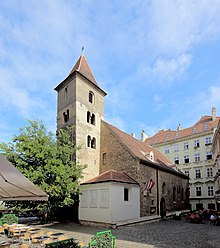Ruprechtskirche (Vienna)

The Roman Catholic Ruprechtskirche is the oldest still existing church in the city of Vienna . It is located on Ruprechtsplatz in Vienna's 1st district, Innere Stadt . The Ruprechtskirche is consecrated to St. Rupert , the patron saint of salt boaters and of Salzburg , and is therefore considered to be the foundation of Salzburg. In the Middle Ages, salt was an important monopoly product that was administered by a special body, the Salt Office . In the Ruprechtskirche, salt was sold to retailers by the Salt Office - this is also reminiscent of the field names Salzgasse, Salzgries, Salztorgasse and the Salztorbrücke.
history
According to legend, the church was founded in 740. The first documentary mention was in 1200, in a document that refers to a donation from Duke Heinrich II Jasomirgott to the Schottenstift . This donation also included the Ruprechtskirche, which is referred to as the oldest church in Vienna. From today's perspective, however, this is not correct, as the first St. Peter's Church was the oldest church in Vienna, making the Ruprecht's Church the oldest still preserved church in Vienna.
The Ruprechtskirche is located in the area of the former Roman military camp Vindobona . After the destruction of the Roman settlement, the nucleus of what would later become Vienna emerged in the area around the Ruprechtskirche. It was the parish of Vienna before this function was transferred to St. Stephen's Cathedral in 1147 .
The current church has been changed and rebuilt several times. The oldest walls that have survived to this day date from the early 12th century (the walls of the main nave with the gallery and the lower tower floors with the Romanesque biforia). The church was damaged during a major fire in 1276, which destroyed almost the entire city center, and was then Gothicized (construction of the new, polygonal apse and elevation of the tower by one storey). Probably in the middle of the 14th century was on the right side of the nave , a Gothic nave grown and the south wall of the nave by three ogival arcades broken. On the gallery parapet there is an AEIOU inscription with the year 1439. This is the motto of Emperor Friedrich III. , and the year he became Duke of Austria.
The Salzamtmann Georg Nagl was the inscription of 1622 the very dilapidated Ruprechtskirche restore, Johann Baptist Bartolotti of Partenfeld funded the repair of the years 1701 to 1703. For floor panels in the front door, as well as stages of a small staircase to the gallery Kaiserstein was from Kaisersteinbruch used .
In the Ruprechtskirche there are on the one hand the oldest glass windows in Vienna (in the center of the apse, 3rd quarter of the 13th century), on the other hand, since 1993, 22 modern glass windows by Lydia Roppolt . The dominant feature here are the three large windows on the right in the nave, a cycle on the theme of “Praise to God for salvation from deepest need”: Daniel in the lions' den, Jonah and the whale and the three young men in the fiery furnace. The other windows are about “Praise of Creation”. Windows by Heinrich Tahedl (1949) are located to the left and right of the Gothic windows in the apse . The cast bronze tabernacle with barrel staves was created by Ignaz Kienast in 1998 .
The first church rector of the parish of St. Ruprecht was Joop Roeland OSA, his successor was Gernot Wisser SJ. P. Alois Riedlsperger SJ is currently the church rector of the church.
Picture gallery
Bones of Saint Vitalis of Milan
Web links
- Ruprechtskirche in the Vienna History Wiki of the City of Vienna
- Parish St. Ruprecht of the Archdiocese of Vienna
- The Ruprechtskirche on the website of planet-vienna.com
- The Ruprechtskirche on the suf.at website
Individual evidence
- ↑ Christian Art Centers Austria, No. 314, Verlag St. Peter, Salzburg 1998
Coordinates: 48 ° 12 ′ 43.5 ″ N , 16 ° 22 ′ 27.5 ″ E





